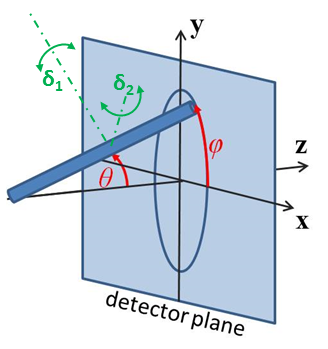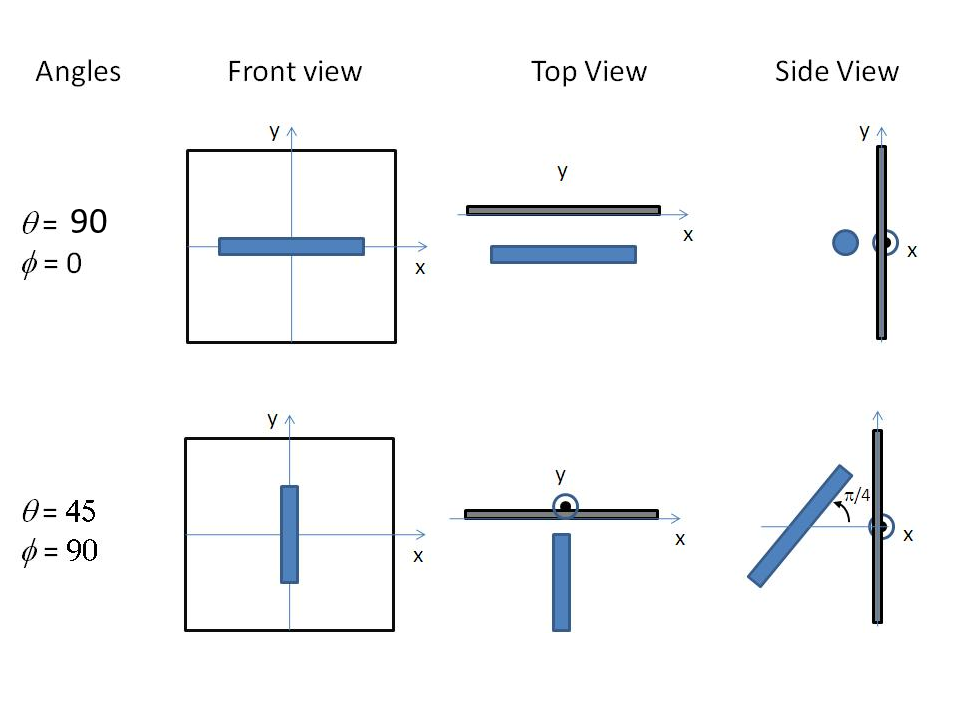cylinder¶
Right circular cylinder with uniform scattering length density.
Parameter |
Description |
Units |
Default value |
|---|---|---|---|
scale |
Scale factor or Volume fraction |
None |
1 |
background |
Source background |
cm-1 |
0.001 |
sld |
Cylinder scattering length density |
10-6Å-2 |
4 |
sld_solvent |
Solvent scattering length density |
10-6Å-2 |
1 |
radius |
Cylinder radius |
Å |
20 |
length |
Cylinder length |
Å |
400 |
theta |
cylinder axis to beam angle |
degree |
60 |
phi |
rotation about beam |
degree |
60 |
The returned value is scaled to units of cm-1 sr-1, absolute scale.
For information about polarised and magnetic scattering, see the Polarisation/Magnetic Scattering documentation.
Definition
The output of the 2D scattering intensity function for oriented cylinders is given by (Guinier, 1955)
where
and \(\alpha\) is the angle between the axis of the cylinder and \(\vec q\), \(V =\pi R^2L\) is the volume of the cylinder, \(L\) is the length of the cylinder, \(R\) is the radius of the cylinder, and \(\Delta\rho\) (contrast) is the scattering length density difference between the scatterer and the solvent. \(J_1\) is the first order Bessel function.
For randomly oriented particles:
The output of the 1D scattering intensity function for randomly oriented cylinders is thus given by
NB: The 2nd virial coefficient of the cylinder is calculated based on the radius and length values, and used as the effective radius for \(S(q)\) when \(P(q) \cdot S(q)\) is applied.
For 2d scattering from oriented cylinders, we define the direction of the axis of the cylinder using two angles \(\theta\) (note this is not the same as the scattering angle used in q) and \(\phi\). Those angles are defined in Fig. 21 , for further details see Oriented Particles.

Fig. 21 Angles \(\theta\) and \(\phi\) orient the cylinder relative to the beam line coordinates, where the beam is along the \(z\) axis. Rotation \(\theta\), initially in the \(xz\) plane, is carried out first, then rotation \(\phi\) about the \(z\) axis. Orientation distributions are described as rotations about two perpendicular axes \(\delta_1\) and \(\delta_2\) in the frame of the cylinder itself, which when \(\theta = \phi = 0\) are parallel to the \(Y\) and \(X\) axes.¶

Fig. 22 Examples for oriented cylinders.¶
The \(\theta\) and \(\phi\) parameters to orient the cylinder only appear in the model when fitting 2d data.
Validation
Validation of the code was done by comparing the output of the 1D model to the output of the software provided by the NIST (Kline, 2006). The implementation of the intensity for fully oriented cylinders was done by averaging over a uniform distribution of orientations using
where \(p(\theta,\phi) = 1\) is the probability distribution for the orientation and \(P_0(q,\theta)\) is the scattering intensity for the fully oriented system, and then comparing to the 1D result.

Fig. 23 1D and 2D plots corresponding to the default parameters of the model.¶
Source
cylinder.py
\(\ \star\ \) cylinder.c
\(\ \star\ \) gauss76.c
\(\ \star\ \) sas_J1.c
\(\ \star\ \) polevl.c
References
Pedersen, Adv. Colloid Interface Sci., 70 (1997) 171-210
Fournet, Bull. Soc. Fr. Mineral. Cristallogr., 74 (1951) 39-113
Onsager, Ann. New York Acad. Sci., 51 (1949) 627-659
Authorship and Verification
Author:
Last Modified by: Paul Butler (docs only) November 10, 2022
Last Reviewed by: